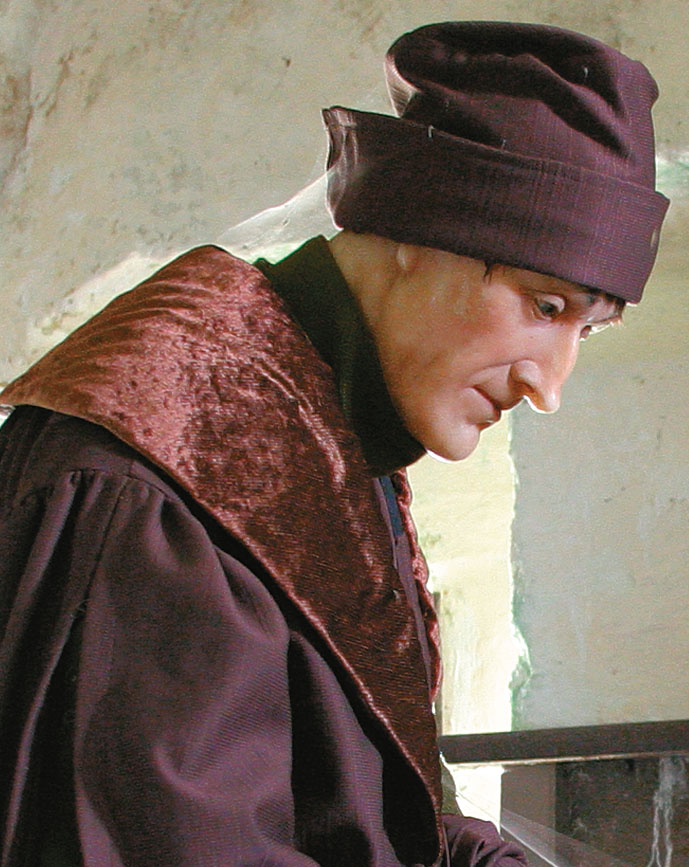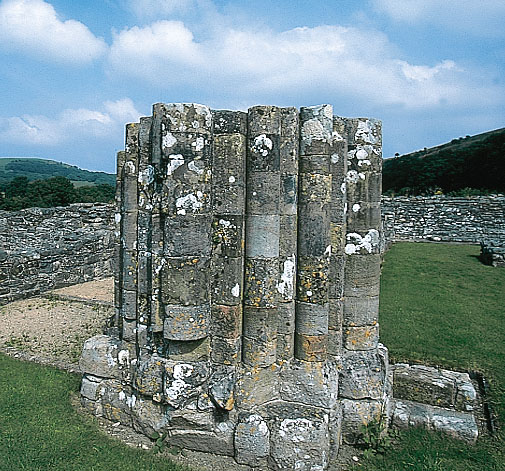
While Eleanor of Aquitaine shook the thrones of England and France, an ambitious monk chronicled life in 12th-century Wales.
[caption id="GeraldsCambrianEra_Feature" align="aligncenter" width="1024"]

RANDALL HYMAN
TWO OF GERALD’S 17 MANUSCRIPTS
WERE DETAILED JOURNALS OF HIS TRIP AROUND WALES IN 1188
“It’s a shame we don’t have access to it just now, but apparently it’s a seven-seater,” manager Andrea Williams declared while strolling past a stony restroom at Pembroke Castle, one of Wales’ largest medieval fortresses. “Privacy wasn’t a priority back then,” she added with a wry smile.
As Williams led me from the castle’s oldest section, the Norman Hall (circa 1150), to the beautifully restored 13th-century outer ward, I caught glimpses of knights greeting damsels in the lush green courtyard below and archers practicing marksmanship on bales of hay. Not ghosts, they were part of Pembroke Castle’s annual medieval festival. It was clear that far more than seven-seaters separated our modern world from theirs.
“This would have been a typical meal,” Williams explained as we entered the dining hall and studied a tableau of supping mannequins that she had painstakingly researched. “They shared bowls and picked up their food with their fingers. The only utensils were spoons for the thick pottage and a personal knife. Men used daggers.”
To explore this medieval stew of Welsh princes, Norman lords and Saxon kings, I was traveling in southwest Wales guided by ancient Cambria’s greatest spokesman, Gerald de Barri, aka Giraldus Cambrensis or Gerald of Wales (circa 1146–1223). He was a cleric and author whose books grew famous for their personal and human details in an era when most writing was strictly liturgical or documentary. Two of his 17 manuscripts, The Journey Through Wales (1191) and The Description of Wales (1194), were the Fodor’s of their time. They were essentially journals of his trip around Cambria in 1188 with Archbishop Baldwin of Canterbury to recruit soldiers for the Third Crusade. My own trip there focused on three sites in Pembrokeshire within an easy hour’s drive of one another: Pembroke Castle, St. David’s Cathedral and Manorbier Castle.
[caption id="GeraldsCambrianEra_img1" align="aligncenter" width="689"]

RANDALL HYMAN
While The Journey is s4teeped in moralistic anecdotes and diaries of preaching the cross, The Description is fascinating for its straightforward reports on everything from agriculture to hairstyles to travel tips:
When you travel there is no question of you asking for accommodation or their offering it: you just march into a house and hand over your weapons to the person in charge. They give you water so that you may wash your feet and that means that you are a guest….Guests who arrive early in the day are entertained until nightfall by girls who play to them on the harp….You sit down in threes, not in pairs as elsewhere, and they put the food in front of you, all together, on a single large trencher containing enough for three, resting on rushes and green grass.
Gerald’s Norman grandfather, Gerald of Windsor, could easily have filled in for one of the stony-faced figures in Pembroke Castle’s dining hall, having defended and ruled the fortress in the early 1100s. Gerald’s Welsh grandmother, however, wasn’t likely to have sat in one place too long. Indulging in numerous affairs, beautiful Nest was Helen, Cleopatra and Salome rolled into one. She even arranged her own abduction for one liaison and bore children by several highborn lovers, including Henry I.
Those same Welsh roots and his unconcealed desire to establish St. David’s as an independent archdiocese free of Canterbury’s yoke deprived Gerald of his ultimate dream, the archbishopric. Despite friendships with popes, kings, princes and lords, the prize eluded him on several occasions during his long life.
“You know what they say—two pilgrimages to St. David’s are worth one to Rome,” silver-haired bookseller Chris Taylor commented, peering over his spectacles at St. David’s book-shop. It is a popular adage based on a 12th-century papal decree to the same effect, attesting both to the remoteness of St. David’s and to its political power.
[caption id="GeraldsCambrianEra_img2" align="aligncenter" width="1024"]

RANDALL HYMAN
[caption id="GeraldsCambrianEra_img3" align="aligncenter" width="1024"]

RANDALL HYMAN
MIRACLES LITTER THE JOURNEY AND ASTONISHING THINGS REAR THEIR UGLY HEADS
It was here, on the marshy banks of the River Alun, that the patron saint of Wales founded his monastic center in the 6th century. As an ascetic, David rejected worldly comforts, tilled the soil, ate no meat and wore only animal skins. Gerald admired his example, despising the excesses of his own peers and writing a biography on St. David.
Taylor’s bookstore features a varied selection of Welsh topics, including Gerald’s Wales journals. Historians prize these books for their rare look at 12th-century life as well as their insights into the brilliant Archdeacon Gerald, Wales’ greatest Latin scholar. Besides his native Norman French, he understood Welsh and a little English, scorning the latter as the “hissing of geese.” He called the English “the most worthless race under Heaven….In their own country they are the slaves of the Normans, and in Wales they serve only as cowherds…and cleaners of sewers.”
The Welsh and Normans, by contrast, were worthy foes in a wild land where natural and supernatural comfortably coexisted. Gerald cites bizarre tales of enchantments and curses as casually as he reports on beavers building lodges, pack horses struggling in quicksand and orioles singing at day’s end.
Miracles litter Gerald’s journey, and far more astonishing things than septuplet commodes rear their ugly “heads.” He relates tales of dogs with monkey heads, a knight giving birth to a calf and half-human incubi seducing innocent maidens to breed more demons. After a long passage in The Journey about diminutive humans in an underground world, Gerald writes, “If, careful reader, you should ask me if I think that this story of the little folk is really true, I can only answer with Augustine that ‘miracles sent by heaven are to be wondered at, not argued about or discussed.’”
Down the hill from Taylor’s bookshop stands the Tower Gate, the only remnant of four original entrances to the cathedral close with a grand overview of St. David’s, a sprawling campus of vast greens, the Bishop’s Palace ruins and an imposing cathedral. Though Bishop Peter de Leia was busy constructing this very cathedral during Archbishop Baldwin’s visit, Gerald makes no mention of it. It is a glaring omission, but at least he writes well of de Leia.
Often jealous and vengeful in his manuscripts, Gerald suppressed his anger over King Henry II appointing de Leia bishop despite overwhelming Welsh and Norman support for himself. Seeing the bishop’s impressive cathedral construction must have been salt in his wound. In later books the gloves are off as he stridently criticizes kings, princes and clerics who wronged him, titling one volume Reproaches.
[caption id="GeraldsCambrianEra_img4" align="aligncenter" width="421"]

RANDALL HYMAN
Tucked in a rear chapel beyond the soaring nave, the cathedral houses two stone monuments to Gerald. One, a defaced tomb cover, is tentatively attributed to him. The other, a statue with quill in hand, celebrates him as immortal bard, though he died a bitter, disillusioned man in 1223 at the age of 77.
Throughout his life as a cleric, Gerald was a man full of opinions and contradictions. Chapters from the final section of The Description include “The Sins of the Welsh,” “How the Welsh Can Be Conquered” and “How the Welsh Can Best Fight Back.” To understand him better, I headed for his childhood home, Manorbier Castle, inspiration for some of his finest prose. He wrote:
[caption id="GeraldsCambrianEra_img5" align="aligncenter" width="1024"]

RANDALL HYMAN
JOURNEY NOTES
Pembrokeshire boasts some of the finest beaches and coastal landscapes in Wales, especially in the St. David’s region. Pembrokeshire Coast National Park’s Web site is a good guide to hiking, swimming, fishing and boating. The town of St. David’s is cozy and charming with several festivals throughout the year. Pembroke Castle is remarkable far beyond Gerald of Wales, especially as the birthplace of the Tudor dynasty. The town of Manorbier offers a cozy, rural holiday setting.
Web sites:
Wales Tourist Board: www.visitwales.com
Croeso Network: www.croeso.net
Boats on their way to Ireland from almost any part of Britain scud by before the east wind, and from this vantage point you can see them brave the ever-changing violence of the winds and the blind fury of the waves. This is a region rich in wheat, with fish from the sea and plenty of wine for sale. What is more important than all the rest is that, from its nearness to Ireland, heaven’s breath smells so wooingly there…in all the broad lands of Wales, Manorbier is the most pleasant place by far.
Growing up in a Norman fortress, Gerald and his three brothers lived under the constant threat of Welsh attack. His people were foreigners, occupiers and land-hungry invaders who spoke French. Called “Marchers” for their relentless march westward across Britain to claim lands not theirs, they were much like American frontiersmen or South African Boers—tough, resourceful and emboldened by a sense of manifest destiny. They surrounded themselves with Flemish farmers as a buffer against the Welsh and commanded their lands from fortresses or fortified mansions like Manorbier.
Despite all this, the insurgent Welsh leader Lord Rhys ap Gruffyd spared Manorbier his wrath, perhaps because Gerald’s mother was his niece. While his brothers chose swords, Gerald took up the cross. His paternal uncle, then bishop of St. David’s, shipped the boy off to Gloucester Abbey for a religious education at age 9 or 10. In his midteens Gerald moved on to the University of Paris for another 10 years of training. His brothers, meanwhile, continued Marcher tradition by joining the Norman invasion of Ireland in the early 1170s.
Manorbier is, as Gerald writes, a most pleasant place. The castle sits atop a limestone bluff, surrounded by a long stone wall, with views of sea and shore. It is small, almost cozy, a humble assortment of half-restored halls with good spots for reflecting on the man who gave the modern world such an intimate look at ancient Cambria.
Wandering the stairways and rooms of Manorbier Castle, I finally came upon the bard himself; tucked in a small room atop a narrow spiral stairway stood a robed mannequin with quill in hand. It was a contemplative Gerald about to write sweet prose, or perhaps bitter vitriol. Bright sun poured through a small window, filling the room with an ethereal light. A dusty cobweb stretching from his hat to the back collar of his burgundy robe, frozen in the still castle air, appeared to hold his head aright as he leaned forward. The web seemed a metaphor for Gerald’s own writings, ancient strands of words tugging somewhere at the back of every Welshman’s mind, forever connecting past to present.
STRATA FLORIDA’S REINS OF POWER
“History doesn’t really die, otherwise it wouldn’t repeat itself!” declared Christine Thompson, sitting atop ruins at Strata Florida, a Cistercian abbey founded in 1164. Her group had come to this remote valley in mid-Wales to walk among the tombs of Welsh princes and plumb the ancient monastery’s crumbled walls with new-age visions. One companion stood beneath an arched portal silently moving his arms up and down in search of auras. He looked daft, but we had similar missions.
[caption id="GeraldsCambrianEra_img6" align="alignright" width="505"]

RANDALL HYMAN
I was reaching back eight centuries to imagine Archdeacon Gerald of Wales with Archbishop Baldwin and his retinue passing through this archway on their way north to Snowdonia. They were traveling through Wales to stir up religious zeal and enlist soldiers for the Third Crusade. Strata Florida was a growing power center, a product of the monastic revival sweeping Europe, with vast landholdings and a valuable scriptorium. Aligned with a Welsh prince, the abbey monks were important political brokers. Gerald needed them, but did they need him?
As a well-known author he had written two books about the geography and conquest of Ireland, which his Norman relatives had invaded just as they had invaded Wales. On the other hand, he wanted St. David’s bishopric to become a metropolitan see, reporting directly to Rome instead of to England’s Canterbury. Was Gerald a Norman Marcher bent on power or a Welsh cleric pushing for independence? Either way, he had connections. He was a member of the English court, regularly traveling with the monarch from the empire’s Pyrenees to the Scottish border, and he knew the pope personally from several trips to Rome.
When the bishopric at St. David’s opened up, the monks showed their cards. Gerald needed funds to go petition the pope in Rome. To raise money he requested that the abbey return the valuable collection of his works that he had donated. The monks refused. Furious, Gerald had to buy back his own books.
His trip to Rome was off to a bad start, and ultimately it broke him financially and spiritually. The pope refused his petition, and for the second time in his life he abandoned his bid for the post he had always coveted. History had indeed repeated itself, but three centuries later the abbey’s own fortunes ebbed and, with the dissolution of the monasteries in 1539, Strata Florida’s monks abandoned their own dreams as well.
R.H.





Comments